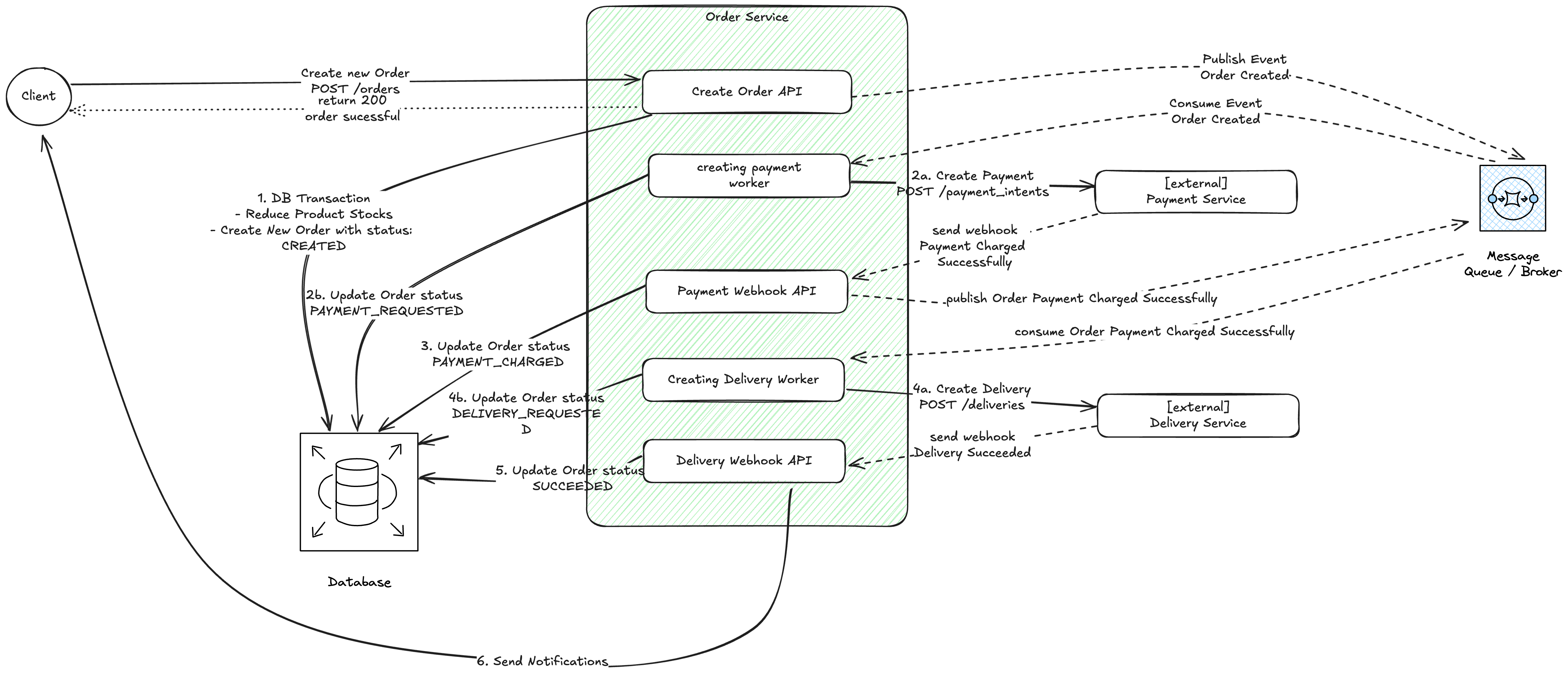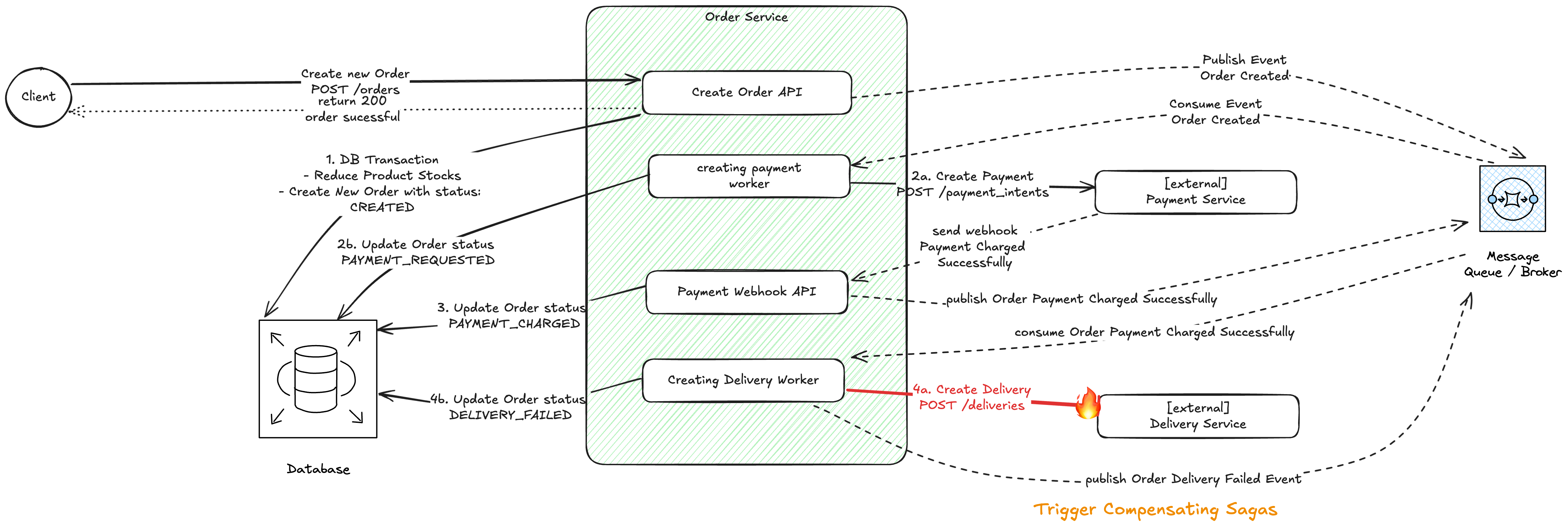Avoid Manual Reconciliation, Solve Stuck Systems Flow using Saga Pattern
[software-architecture backend 
Have you ever encountered case where you need to do manual reconciliation when your systems break? This often happens in transactional flow, in which every request matters.
- Sample Case: E-commerce Order Flow
- A Robust and Elegant Solution?
- Conclusion

Image of "stuck man" was generated by Stable Diffusion
Sample Case: E-commerce Order Flow
Imagine you have an API to create new orders, which have very minimum functionalities:
- Reduce Product Stocks
- Charge Payment to Customers using 3rd party providers like Xendit, Stripe, etc.
- Arrange Delivery of the Product to Customers.

What Could Go Wrong?

Imagine you received errors when creating delivery request after you’ve:
- Reduce Product Stocks Count
- Charge Customers with Payment
This might happen if somehow Delivery Partner API get some downtime. We can try to retry those requests. Let say retrying the requests to delivery service won’t help (they get very long / hours downtime….), You either need to rollback those actions in order to avoid “stuck” states, or manually retry and update the order later.
Customer Complaints: Now What?
Customer got errors, and they want to reorder the product. However, We have charged customer’s money previously and the Product stocks have gone empty since we have reduced the stocks previously (while in fact, it’s not out of stocks yet!). These are typical steps for developers to solve it in short term:
- Increase the product stocks in Database
- Refund the Payment in 3rd Party providers
Or yet another hacky solution:
- Recreate new delivery to Delivery API (externals)
- Update Order status to Completed with Delivery details
If these issues only occur once in a while, it’s fine. Can you imagine you receiving >5x complaints per day? That’d be the most frustrating day to do tedious things over and over again!!!
The Short-Term Fix: Error Handling Logic in the API

So, in case of errors when creating new delivery, your service will do several rollback strategies:
- Restore (Increasing back) the product stocks in Database
- Create Refund Request to 3rd Party providers
- Then, let the client app (frontend) to retry the order requests to your service.
While these measures may help temporarily, there are some drawbacks:
Poor UX for your customers
- Additional Latencies before returning an error to the customer
- Consecutive Payment and Refund for unacceptable reasons, while some payment fees might occurs to Customers end.
Not Robust Enough…
Now we already handled error on Creating New Delivery, what happen if get more errors? For example, you get error when you try to Refund the payment steps. In this case, you can’t apply the same approach as you handled error on Create New Delivery steps , you’ll still need manual intervention to retry the Refund outside of this API call.
A Robust and Elegant Solution?
Key Points:
- Saga Pattern
- Asynchronous Processing
Introducing Saga Pattern
Quoting from https://microservices.io/patterns/data/saga.html
Implement each business transaction that spans multiple services as a saga. A saga is a sequence of local transactions.
- Each local transaction updates the database and publishes a message or event to trigger the next local transaction in the saga.
- If a local transaction fails because it violates a business rule then the saga executes a series of compensating transactions that undo the changes that were made by the preceding local transactions.
I’d like to simplify Saga Pattern like this: ACID, but on microservices / distributed systems — except instead of one large transaction that either fully succeeds or fails, the transaction breaks the process into smaller transactions, each with its own success and rollback logic (compensating transaction).
In the context of an e-commerce order flow, each action (like reducing stock, charging a customer, and arranging delivery) is a saga. If one of these steps/sagas fails, the system can “undo” previous sagas to maintain data consistency. For example, if charging the customer succeeds but arranging the delivery fails, the system can trigger compensating transaction: a refund.
“I’m using Monolithic, not Micro-services…”
Even if you’re using Monolithic, micro-service techniques will become handy . If you’re using Monolithic, but you rely on 3rd party API: you can treat external/3rd parties APIs as other independent microservices. By adding The Saga Pattern to your arsenal, it will help you manage these external dependencies and ensures that your system stays consistent without manual intervention.
Asynchronous Processing
The Saga pattern leverage asynchronous processing — each step in the transaction doesn’t need to wait for the next to complete.
This means Users can complete their transactions without waiting for background tasks like delivery confirmation, making the system feel more responsive. If something fails at any point, the system can handle the rollback without interrupting the overall flow. At the same time, it ensures your system can handle failures gracefully and maintain consistency, even across multiple services or APIs.
How Could we Apply Saga Pattern?
Breaking Down Whole Transactions into Sagas
To apply the Saga Pattern, think of each step in your process (like reducing stock, charging the customer, and arranging delivery) as a separate transaction. Each transaction must have a compensating action to undo its effect if something goes wrong later.
Example: E-commerce Order Flow with Saga
- Reduce Product Stock
- Compensating Action: Increase the stock if the order fails later
- Charge Customer
- Compensating Action: Refund the customer if delivery can’t be arranged.
- Arrange Delivery
- No compensating action needed here if it’s the final step.
Each step in this flow happens asynchronously, allowing the system to recover from errors without manual intervention. If something fails at any step, the saga will automatically trigger the compensating actions for the previous steps, ensuring that the system stays consistent.
Coordinating the Saga
There are two common ways to coordinate sagas:
- Orchestration: A central controller (orchestrator) coordinates the saga, telling each service when to perform its action and when to trigger compensating actions.~~
- Choreography: Each service listens for events and decides on its own whether to take an action or trigger a compensating action based on the event’s outcome.~~
Both approaches have their pros and cons. Orchestration offers more control and is easier to debug, but can become complex. Choreography is more decentralized and works well when each service is independent, but it can be harder to track failures.
We’ll use the most simple use case, which will use monolithic architecture. Thus, the most relevant coordinating strategy would be orchestration.
How Could Saga Pattern Handle Failures?
The key strength of the Saga Pattern is its ability to gracefully handle failures in distributed systems by breaking processes into smaller, manageable transactions. Each step in the saga either completes successfully, or it triggers a compensating transaction to undo any previous actions. This ensures that your system remains consistent, even when things go wrong.
Let’s revisit our e-commerce example:
- Reduce Product Stock
- Success: Move to the next step.
- Failure: No action needed, as the system hasn’t made any changes yet.
- Charge Customer
- Success: Proceed to arrange delivery.
- Failure: Trigger compensating transaction to increase stock back to the original amount.
- Arrange Delivery
- Success: The saga is complete.
- Failure: Trigger compensating transactions for both previous steps:
- Refund the customer.
- Restore product stock.
Common Pitfalls ❌
When to determine whether we retry or trigger compensating Transaction?
You need to categorize type of errors in each saga/transactions, whether it’s retriable or not. My rule of thumbs to categorize it:
- Not retriable: If the errors caused by the business logic itself. In our E-commerce example, these could be:
- Insufficient balance on Customer’s Bank Account
- Bank Rejected the payment request
- Delivery can’t be arranged due to logistic issues on partner side.
- Retriable: If the errors caused by network errors, partner downtime, and other unknown failures.
If the error is not retriable, thus we need to trigger the compensating sagas/transactions. Else, we will retry the transaction based on a predefined strategy (e.g., exponential backoff).
What if Message gets processed Twice? (e.g. Double Payment Charged)
There are several factor that can lead to these conditions:
- Message gets published twice
- Consumer crashes in the middle of the process (e.g. after it calls external dependencies), causing consumers to retry the message consumptions.
The main principle to safeguard this is idempotency. This is very broad topic and will need dedicated page to cover. In nutshell, we need to ensure: Retrying any message consumption will always result the same behavior.
Example Processing Payment Creation in Consumer
- Payment API (External) usually require its consumer to provide
idempotency-keyfor each payment request. This is to ensure that payment will only be created once in expected states. - Common technique to generate
idempotency-keyfrom consumer side is to use unique value such asorder_id.
What if a Compensating Transaction Fails?
One of the trickiest problems in distributed systems is when the compensating transaction (e.g., refunding the customer) also fails. The Saga Pattern accounts for this by incorporating retries and allowing for manual intervention if needed. This way, you can ensure that failures don’t result in inconsistent states or data loss.
For example, if a refund fails after an order delivery error, the saga will retry the refund based on a predefined strategy (e.g., exponential backoff). If the retries still fail, the system can log the issue and flag it for manual resolution. This ensures that your system can recover even in edge cases. Edge cases will always exist, but we try to minimize them as much as possible.
Solution on E-commerce Order Flow
State Machine Diagram
It’s recommended to draw a state diagram, so you can understand the whole transaction from high level perspective. This will be beneficial as well for communicating with non-developers stakeholders.
stateDiagram-v2
state "Order Accepted" as ACCEPTED
state "Product Stock Reduced" as STOCK_REDUCED
state "Payment Requested" as PAYMENT_REQUESTED
state "Payment Charged Sucessfully" as PAYMENT_CHARGED
state "Delivery Requested" as DELIVERY_REQUESTED
state "Delivery Failed" as DELIVERY_FAILED
state "Delivery Succeeded" as DELIVERY_SUCCEEDED
state "Order Succeeded" as SUCCEEDED
state "Order Failed" as FAILED
state "Failed Payment Compensating Sagas" as FailedPaymentSagas {
state "[compensating txn]\nProduct Stock Restored" as STOCK_RESTORED
[*] --> STOCK_RESTORED
STOCK_RESTORED --> [*]
}
state "Failed Delivery Compensating Sagas" as FailedDeliverySagas {
state "[compensating txn]\nProduct Stock Restored" as STOCK_RESTORED2
state "[compensating txn]\nRefund Requested" as REFUND_REQUESTED
state "Refund Succeeded" as REFUND_SUCCEEDED
[*] --> STOCK_RESTORED2
[*] --> REFUND_REQUESTED
REFUND_REQUESTED --> REFUND_SUCCEEDED: successfully refund the money to customer
REFUND_SUCCEEDED --> [*]
STOCK_RESTORED2 --> [*]
}
[*] --> ACCEPTED: received order from user
ACCEPTED --> STOCK_REDUCED: product stock reduced
STOCK_REDUCED --> PAYMENT_REQUESTED: payment requested to Payment Partner
PAYMENT_REQUESTED --> PAYMENT_CHARGED: succeeded to charge payment by Payment Partner
PAYMENT_CHARGED --> DELIVERY_REQUESTED: delivery requested to Delivery Partner
DELIVERY_REQUESTED --> DELIVERY_FAILED: failed to arrange delivery
DELIVERY_FAILED --> FailedDeliverySagas: failed to arrange delivery
PAYMENT_REQUESTED --> FailedPaymentSagas: failed to charge payment to customer\n(e.g. insufficient balance, rejected by bank, etc.)
DELIVERY_REQUESTED --> DELIVERY_SUCCEEDED: delivery succeeded to Delivery Partner
DELIVERY_SUCCEEDED --> SUCCEEDED: all sagas succeeded, marking order as succeeded
SUCCEEDED --> [*]
FailedDeliverySagas --> FAILED: All compensating transaction has been executed
FailedPaymentSagas --> FAILED: All compensating transaction has been executed
FAILED --> [*]
Architecture Diagram

The main difference between the solution and initial architectures are:
- Decoupling Create Order API to several components based on defined sagas
- Happy Path Flow
- Creating Payment Worker
- Creating Delivery Worker
- Failed Delivery Compensating Sagas
- Creating Refund Worker
- Restore Product Stock Worker
- Failed Payment Compensating Sagas
- Restore Product Stock Worker
- Happy Path Flow
- Leveraging Message Broker/Queues as the communication hub between sagas component
While we’ve split the API into multiple components, this doesn’t mean you need separate servers. Depending on your needs (capacity planning), these components can run as simple as background processes within the same server.
Happy Path Flow Diagram

In this flow, each action succeeds and moves to the next sagas:
- Order Accepted
- Create Order API → Order Service creates the order and reduces product stock.
- Creating Payment Worker → payment is requested from the payment partner.
- Payment Charged
- Payment Webhooks API → Order Service update the order status to PAYMENT_CHARGED
- Creating Delivery Worker → Order Service arranges product delivery.
- Delivery Succeeded
- Delivery Webhooks API → the order is marked as successful.
In this path, no compensating transactions are triggered, and the entire process completes smoothly.
Failed Delivery Compensating Saga Flow Diagram
Here’s the scenario when the delivery proccess is failed.

- Order Accepted
- Create Order API → Order Service creates the order and reduces product stock.
- Creating Payment Worker → payment is requested from the payment partner.
- Payment Charged
- Payment Webhooks API → Order Service update the order status to PAYMENT_CHARGED
- Creating Delivery Worker → Order Service arranges product delivery.
- Delivery Failed → Trigger Compensating Sagas

- Trigger Refund
- Create Refund Worker → the system triggers a refund request to the payment provider.
- Refund Succeeded → the system restores product stock and marks the order as failed.
- Trigger Product Stock Restored → the system restores product stock and marks the order as failed.
This ensures no “stuck” states exist, and the customer gets their money back.
Conclusion
Even if you’re using monolithic architecture, you can leverage Saga Pattern for managing complex and multi-step processes in distributed systems. Implementing this pattern will reduce manual intervention, improves system reliability, and ensures smooth developer experiences even when things go wrong.
What’s next? 🤔
- Code Implementation on E-commerce Order Flow using Saga Pattern
- Ensuring Idempotency in Message Consumption
- Monitoring and Observability in Sagas